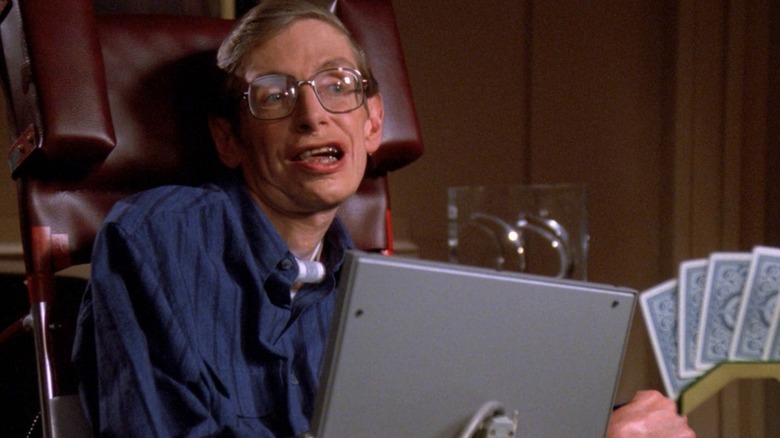Stephen Hawking’s Star Trek Cameo Has A Unique Distinction
At the beginning of the “Star Trek: The Next Generation” episode “Descent, Part I” (June 21, 1993), Data (Brent Spiner) is spending some free time on the holodeck. He has arranged a poker game with three of the greatest minds the scientific community has ever known. Sir Isaac Newton (John Neville) is arrogant and impatient. Albert Einstein (Jim Norton) is affable, but an aggravating poker player, as he struggles with basic arithmetic. And, sitting across from Data, making science jokes and poking fun at Newton and Einstein, is Stephen Hawking, playing himself.
Hawking gets the opening line of the episode, completing an anecdote: “But then I said, in that frame of reference, the perihelion of Mercury would have precessed in the opposite direction.” Einstein laughs, and Data declares the story to be very amusing. Data tries to explain the joke to Newton, who would not have known about the relativistic curvature of space-time. Newton brushes off Data’s explanation, saying he invented physics.
Just as Hawking wins the poker tournament — he held four sevens — Data is called to the bridge of the Enterprise for an emergency. Data shuts off the holodeck, and the intellectual giants vanish. It was a brief but memorable scene in “Star Trek” history.
It also holds a curious distinction among “Star Trek” guest stars. Stephen Hawking is the only person in “Star Trek” history to have played himself. Back in 2018, the writer of “Descent,” Ron D. Moore, talked with The Wrap about Hawking’s visit to the set, and how every single writer and crew member wanted to be on hand to meet him. On “Star Trek,” writers were rarely allowed on set. In this case, however, it seems a lot of exceptions were happily made.
OMG, it’s Stephen Hawking!
Know that “Star Trek” typically tries to be quite ginger about incorporating contemporary references. It has previously been written in the pages of /Film that modern pop music is typically eschewed on “Star Trek” because of its commercial dimension, and because the writers likely wouldn’t want to presume certain pop acts would survive into the 24th century. When it comes to celebrities and the arts, “Star Trek” has preferred to play it safe by only making classical and ancient references, which are not only in the public domain, but already such a deeply entrenched part of Earth culture, that it’s safe to assume their memory would persist for many additional centuries.
An exception, however, was made for Hawking, as his revolutionary ideas about astral physics transformed the scientific community in his lifetime. What’s more, all the science nerds and space nuts watching “Star Trek” would certainly squee seeing Hawking and Data interacting. When Moore thought to write Hawking into his script, it was easily approved by the higher-ups at Paramount. Luckily, Hawking was game enough to visit the “Star Trek” set and tell a joke about the perihelion of Mercury.
Moore recalled that the actual filming required the usual camera operators, actors, et al, but that everyone else crammed the set, hoping to meet a hero. Moore said:
“Only the people involved in filming the scene were actually allowed in the room. […] Everyone else was crammed out in the hallway peeking in. It was a really exciting scene and one that had never been done before on ‘Star Trek.'”
It seems that executive producer Rick Berman ultimately was able to contact Hawking because of a previous set visit the famed physicist had made. Hawking’s number was already in Berman’s Rolodex.
The Errol Morris connection
It seems that back in 1991, Hawking visited the Paramount lot to introduce a screening of Errol Morris’ biographical documentary “A Brief History of Time.” Rick Berman had learned that Hawking was a Trekkie, and arranged a mutually beneficial geekout by inviting Hawking to the set. It was during the visit that Berman learned that Hawking would love to be a TV star. Hawking, of course, was a busy man — he was the Lucasian Professor of Mathematics at Cambridge — so it would take several more years before everything timed out correctly. As Moore recalled:
“After that visit, we learned that Hawking would be interested in doing a cameo on the show, and there was a window of time when he was going to be back in Los Angeles, and I was going to write the episode they were going to film during that window. […] So I got the call and they told me, ‘We need you to write a scene with Stephen Hawking,’ and I’m like, ‘Wait, WHAT?!’ But they told me to do something on the holodeck, maybe with Data.”
The resulting scene opened “Descent,” the final episode of the show’s sixth season. Moore was able to come up with the scenario, but he wasn’t well-versed enough in physics to write an appropriately brainy science joke for Hawking. Moore admits that he reached out to fellow Trek writer Naren Shankar, who had three degrees and a deeper understanding of perihelia. Moore said:
“Naren had a Ph.D. in applied physics, so I brought him in, and he was also tickled at the idea of writing lines for Stephen Hawking. So he was the one who came up with the idea of the joke being that Stephen keeps busting the chops of the other scientists and that Isaac Newton is a jerk and that Einstein and Stephen keep bagging on him. Once we had that, the scene just wrote itself.”
It all came together swimmingly. Hawking was happy, the makers of “Star Trek” were happy, and Trekkies were happy. Sometimes, nerd crossovers work out.

















Post Comment